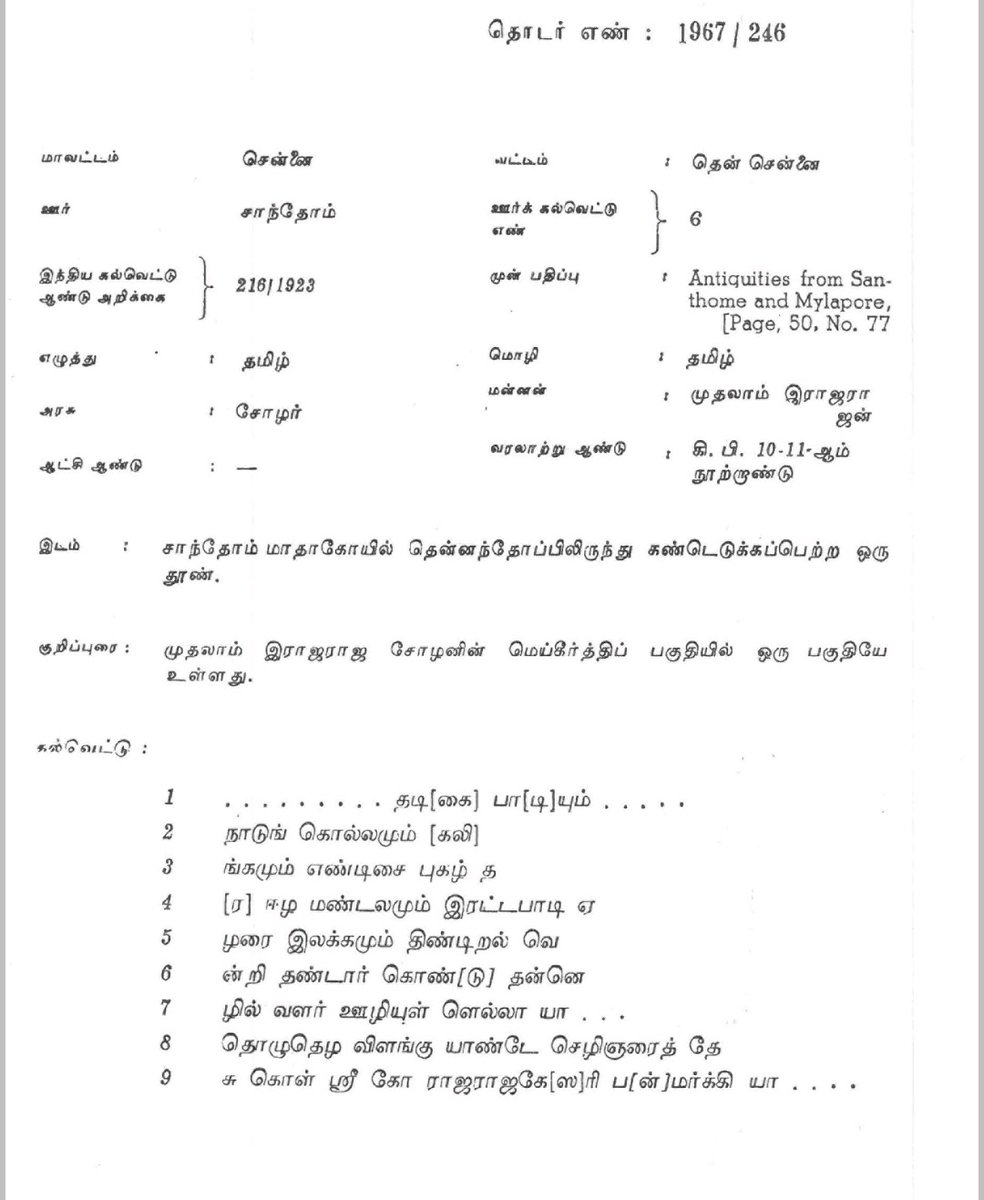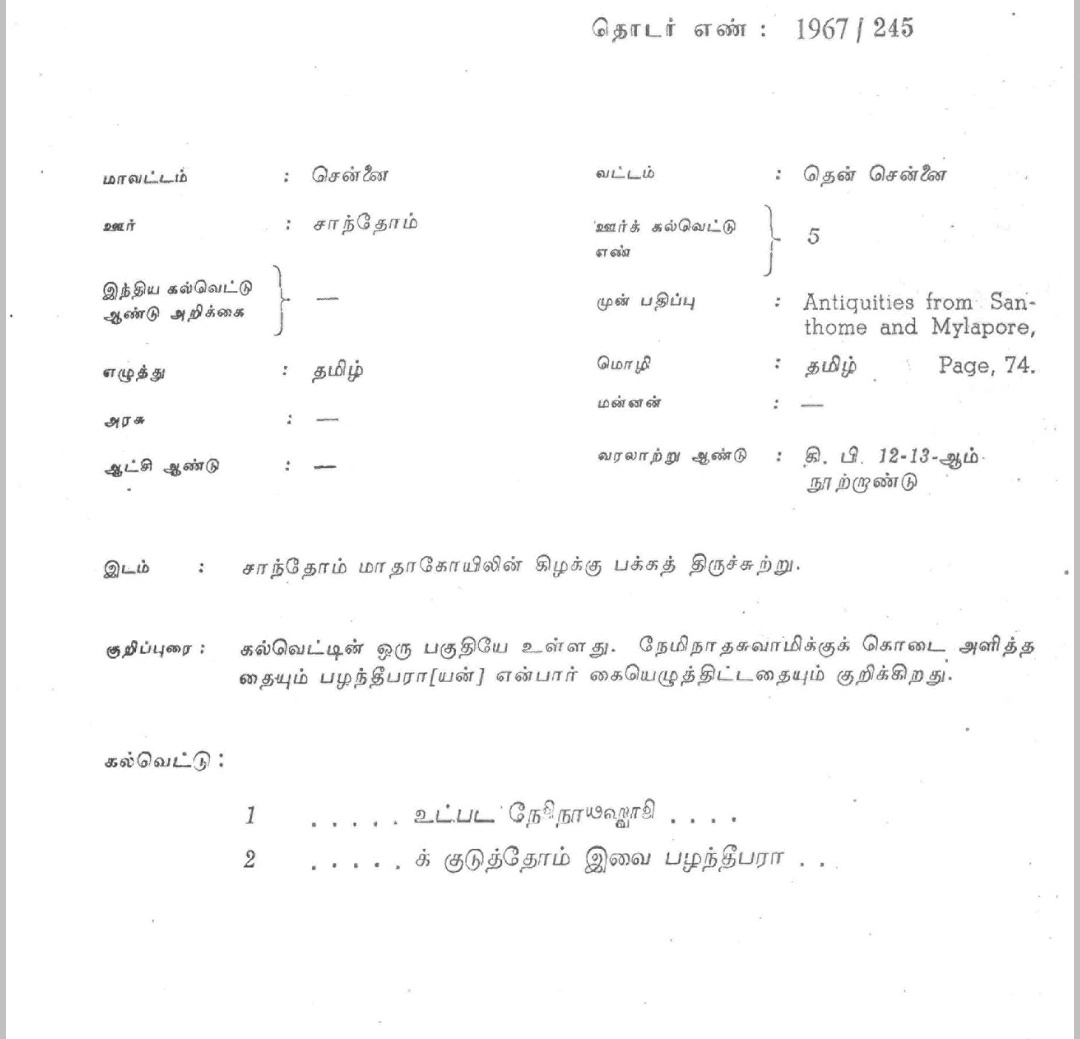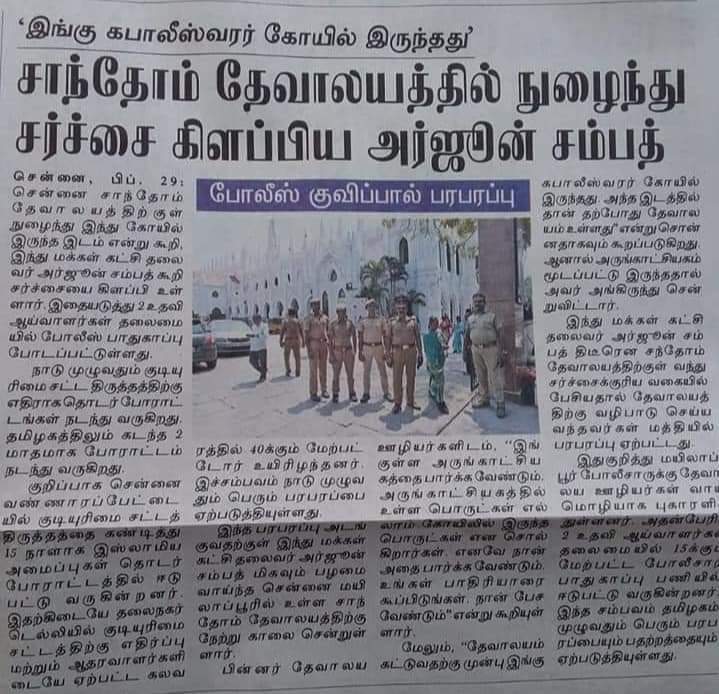இது அனைத்தும் தமிழ் நாடு அரசு தொல்லியல் துறை வெளியீடான சென்னை மாநகரக் கல்வெட்டு புத்த்கத்தில் இடம் பெற்றுள்ளவை.
அர்ஜுன் சம்பத் எந்த சர்ச்சையையும் உருவாக்கவில்லை.
மக்கள் உண்மையான வரலாற்றை அறிந்து கொள்ள வேண்டும் என்று அவர் விரும்பினார்.
சாந்தோம் தேவாலயம் இந்து இரத்தத்தில் கட்டப்பட்டது என்பதை IMK உலகுக்கு சொல்ல விரும்புகிறோம்.
மக்கள் உண்மையான வரலாற்றை அறிந்து கொள்ள வேண்டும் என்று அவர் விரும்பினார்.
சாந்தோம் தேவாலயம் இந்து இரத்தத்தில் கட்டப்பட்டது என்பதை IMK உலகுக்கு சொல்ல விரும்புகிறோம்.
Iyadigal Kadavarkon, the sixth century Shaivite prince of Kanchipuram, Jnanasambandar and Arunagirinathar, the sixth and fifteenth century Shaivite poets, consistently mention in their hymns that the Kapaleeswara Temple was on the seashore.
Jnanasambandar writes,
“The Lord of Kapaleeswaram sat watching the people of Mylapore — a place full of flowering coconut palms — taking ceremonial bath in the sea on the full moon day of the month of Masai.”
“The Lord of Kapaleeswaram sat watching the people of Mylapore — a place full of flowering coconut palms — taking ceremonial bath in the sea on the full moon day of the month of Masai.”
N. Murugesa Mudaliar, in,writes, “Mylapore fell into the hands of the Portuguese in 1566, when the temple suffered demolition. The present temple was rebuilt around three hundred years ago. Fragmentary inscriptions from the old temple are still found in St. Thomas Cathedral.”
P.K. Nambiar, in Census of India 1961, Vol. IX, Part XI, writes “It is a historical fact that the Portuguese, who visited India in the 16th century, had one of their earliest settlements at San Thome, Mylapore. In those days they were very cruel and had iconoclastic tendencies.
.....They razed some Hindu temples to the ground. It is probable that the Mylapore temple referred to in the Thevaram hymns was built on the seashore and that it was destroyed by the Portuguese about the beginning of the 16th century
Ishwar Sharan explains again.
“The Portuguese were familiar with the St. Thomas legend long before they arrived in India. They knew Marco Polo’s Il Milione, made popular in Europe in the fourteenth century, and the earlier sixth century
“The Portuguese were familiar with the St. Thomas legend long before they arrived in India. They knew Marco Polo’s Il Milione, made popular in Europe in the fourteenth century, and the earlier sixth century
Latin romances De Miraculis Thomae and Passio Thomae…The Passio Thomae had St. Thomas killed by a Pagan priest with a sword, and De Miraculis Thomae had him killed by a Pagan priest with a lance.
These stories were at odds with the one found in the Acts of Thomas, which had the apostle executed on the orders of a Persian king, by four royal soldiers with spears.”
“The Portuguese preferred the Pagan-priest-with-a-lance story found in De Miraculis Thomae. They added Marco Polo’s seaside tomb to it, and elements from Syrian Christian traditions that they had gathered in Malabar, and concocted a legend…”
And so here we have how the Pagan-priest–with-a-lance became a wicked-Brahmin-priest-with-a-spear. This was how a St. Thomas who never came to India became a martyr and the local Brahmin priest became the wicked murderer.
This again was the classic instance of the nefarious design of the Christian missionaries to not only convert large masses of Hindus to Christianity, but to also paint the Brahmins as wicked oppressors because they stood as an obstacle in their conversion pursuit.
As Dr. Koenraad Elst says,
“The well-spring of anti-Brahminism is doubtlessly the Christian missionaries’ greedy design to rope in the souls of Hindus. From there onwards, it spread through the entire
“The well-spring of anti-Brahminism is doubtlessly the Christian missionaries’ greedy design to rope in the souls of Hindus. From there onwards, it spread through the entire
English-educated class and ultimately became an unquestionable dogma in India’s political parlance. Communist historians and sociologists have been fortifying it by rewriting Indian history as a perennial struggle between Brahmin oppressors and the rest.
When defending the Mandal report in 1990, the then Prime Minister of India V.P. Singh could say that Brahmins have to do penance for the centuries of oppression which they inflicted on the Backwards, without anyone questioning his historical assumptions.
Anti-Brahminism is now part of the official doctrine of the secular, socialist Republic of India.”
the Catholic Church can malign the Brahmins more confidently. Brahmins have been the main target of its attack from the beginning. Now it can be shown that the Brahmins have always been a vicious brood,
so much so that they would not stop from murdering a holy man who was only telling God’s own truth to a tormented people. At the same time, the religion of the Brahmins can be held responsible for their depravity.
As a consequence, every boy and girl in the country believes that a Mylapore king and his Brahmin priest murdered St. Thomas on Big Mount.
They cannot help but believe it because that is what they are taught “on good authority” either by the teachers in their schools or by the newspapers.
His relics traveled to quite a few places after his death, until most of them found their final resting place in the Basilica di San Tommaso in Ortona, Italy.
https://www.atlasobscura.com/places/relics-of-the-apostle-st-thomas
https://www.atlasobscura.com/places/relics-of-the-apostle-st-thomas
Reference : The Myth of St. Thomas by Tejesvie Surya. http://indiafacts.org/the-mylapore-st-thomas-myth-that-just-doesnt-seem-to-die-part-1/

 Read on Twitter
Read on Twitter








